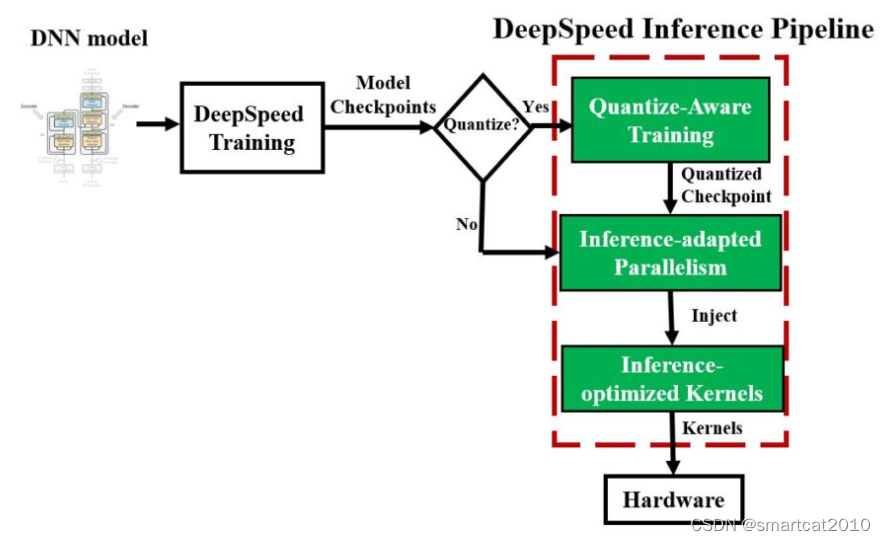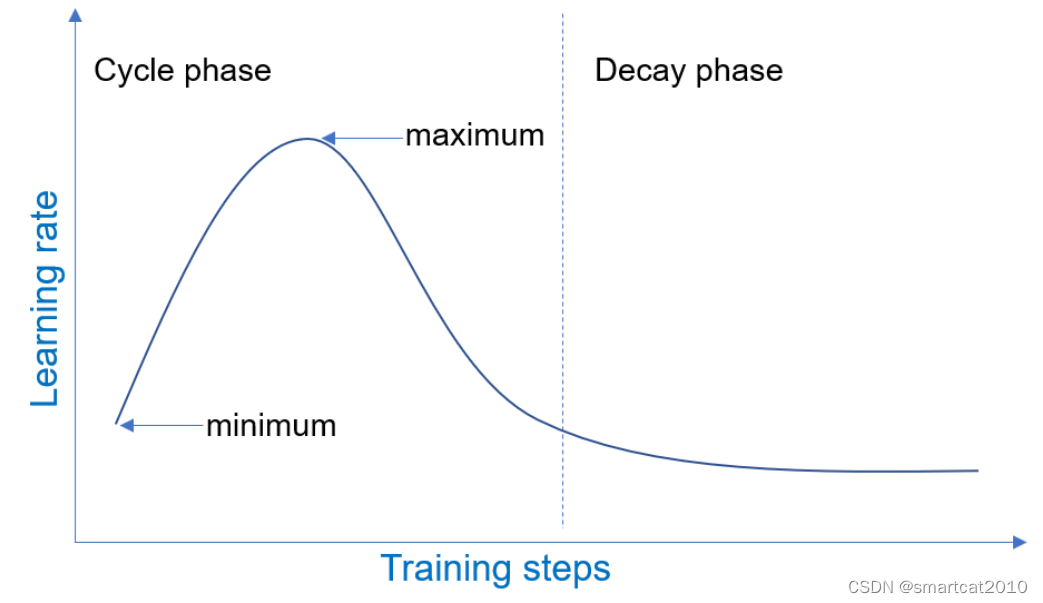本文主要是介绍DeepSpeed Profiling,希望对大家解决编程问题提供一定的参考价值,需要的开发者们随着小编来一起学习吧!
DeepSpeed自带的Profiler
-------------------------- DeepSpeed Flops Profiler -------------------------- Profile Summary at step 10: Notations: data parallel size (dp_size), model parallel size(mp_size), number of parameters (params), number of multiply-accumulate operations(MACs), number of floating-point operations (flops), floating-point operations per second (FLOPS), fwd latency (forward propagation latency), bwd latency (backward propagation latency), step (weights update latency), iter latency (sum of fwd, bwd and step latency)world size: 1 data parallel size: 1 model parallel size: 1 batch size per GPU: 80 params per gpu: 336.23 M params of model = params per GPU * mp_size: 336.23 M fwd MACs per GPU: 3139.93 G fwd flops per GPU: 6279.86 G fwd flops of model = fwd flops per GPU * mp_size: 6279.86 G fwd latency: 76.67 ms bwd latency: 108.02 ms fwd FLOPS per GPU = fwd flops per GPU / fwd latency: 81.9 TFLOPS bwd FLOPS per GPU = 2 * fwd flops per GPU / bwd latency: 116.27 TFLOPS fwd+bwd FLOPS per GPU = 3 * fwd flops per GPU / (fwd+bwd latency): 102.0 TFLOPS step latency: 34.09 us iter latency: 184.73 ms samples/second: 433.07----------------------------- Aggregated Profile per GPU ----------------------------- Top modules in terms of params, MACs or fwd latency at different model depths: depth 0:params - {'BertForPreTrainingPreLN': '336.23 M'}MACs - {'BertForPreTrainingPreLN': '3139.93 GMACs'}fwd latency - {'BertForPreTrainingPreLN': '76.39 ms'} depth 1:params - {'BertModel': '335.15 M', 'BertPreTrainingHeads': '32.34 M'}MACs - {'BertModel': '3092.96 GMACs', 'BertPreTrainingHeads': '46.97 GMACs'}fwd latency - {'BertModel': '34.29 ms', 'BertPreTrainingHeads': '3.23 ms'} depth 2:params - {'BertEncoder': '302.31 M', 'BertLMPredictionHead': '32.34 M'}MACs - {'BertEncoder': '3092.88 GMACs', 'BertLMPredictionHead': '46.97 GMACs'}fwd latency - {'BertEncoder': '33.45 ms', 'BertLMPredictionHead': '2.61 ms'} depth 3:params - {'ModuleList': '302.31 M', 'Embedding': '31.79 M', 'Linear': '31.26 M'}MACs - {'ModuleList': '3092.88 GMACs', 'Linear': '36.23 GMACs'}fwd latency - {'ModuleList': '33.11 ms', 'BertPredictionHeadTransform': '1.83 ms''} depth 4:params - {'BertLayer': '302.31 M', 'LinearActivation': '1.05 M''}MACs - {'BertLayer': '3092.88 GMACs', 'LinearActivation': '10.74 GMACs'}fwd latency - {'BertLayer': '33.11 ms', 'LinearActivation': '1.43 ms'} depth 5:params - {'BertAttention': '100.76 M', 'BertIntermediate': '100.76 M'}MACs - {'BertAttention': '1031.3 GMACs', 'BertIntermediate': '1030.79 GMACs'}fwd latency - {'BertAttention': '19.83 ms', 'BertOutput': '4.38 ms'} depth 6:params - {'LinearActivation': '100.76 M', 'Linear': '100.69 M'}MACs - {'LinearActivation': '1030.79 GMACs', 'Linear': '1030.79 GMACs'}fwd latency - {'BertSelfAttention': '16.29 ms', 'LinearActivation': '3.48 ms'}------------------------------ Detailed Profile per GPU ------------------------------ Each module profile is listed after its name in the following order: params, percentage of total params, MACs, percentage of total MACs, fwd latency, percentage of total fwd latency, fwd FLOPSBertForPreTrainingPreLN(336.23 M, 100.00% Params, 3139.93 GMACs, 100.00% MACs, 76.39 ms, 100.00% latency, 82.21 TFLOPS,(bert): BertModel(335.15 M, 99.68% Params, 3092.96 GMACs, 98.50% MACs, 34.29 ms, 44.89% latency, 180.4 TFLOPS,(embeddings): BertEmbeddings(...)(encoder): BertEncoder(302.31 M, 89.91% Params, 3092.88 GMACs, 98.50% MACs, 33.45 ms, 43.79% latency, 184.93 TFLOPS,(FinalLayerNorm): FusedLayerNorm(...)(layer): ModuleList(302.31 M, 89.91% Params, 3092.88 GMACs, 98.50% MACs, 33.11 ms, 43.35% latency, 186.8 TFLOPS,(0): BertLayer(12.6 M, 3.75% Params, 128.87 GMACs, 4.10% MACs, 1.29 ms, 1.69% latency, 199.49 TFLOPS,(attention): BertAttention(4.2 M, 1.25% Params, 42.97 GMACs, 1.37% MACs, 833.75 us, 1.09% latency, 103.08 TFLOPS,(self): BertSelfAttention(3.15 M, 0.94% Params, 32.23 GMACs, 1.03% MACs, 699.04 us, 0.92% latency, 92.22 TFLOPS,(query): Linear(1.05 M, 0.31% Params, 10.74 GMACs, 0.34% MACs, 182.39 us, 0.24% latency, 117.74 TFLOPS,...)(key): Linear(1.05 M, 0.31% Params, 10.74 GMACs, 0.34% MACs, 57.22 us, 0.07% latency, 375.3 TFLOPS,...)(value): Linear(1.05 M, 0.31% Params, 10.74 GMACs, 0.34% MACs, 53.17 us, 0.07% latency, 403.91 TFLOPS,...)(dropout): Dropout(...)(softmax): Softmax(...))(output): BertSelfOutput(1.05 M, 0.31% Params, 10.74 GMACs, 0.34% MACs, 114.68 us, 0.15% latency, 187.26 TFLOPS,(dense): Linear(1.05 M, 0.31% Params, 10.74 GMACs, 0.34% MACs, 64.13 us, 0.08% latency, 334.84 TFLOPS, ...)(dropout): Dropout(...)))(PreAttentionLayerNorm): FusedLayerNorm(...)(PostAttentionLayerNorm): FusedLayerNorm(...)(intermediate): BertIntermediate(4.2 M, 1.25% Params, 42.95 GMACs, 1.37% MACs, 186.68 us, 0.24% latency, 460.14 TFLOPS,(dense_act): LinearActivation(4.2 M, 1.25% Params, 42.95 GMACs, 1.37% MACs, 175.0 us, 0.23% latency, 490.86 TFLOPS,...))(output): BertOutput(4.2 M, 1.25% Params, 42.95 GMACs, 1.37% MACs, 116.83 us, 0.15% latency, 735.28 TFLOPS,(dense): Linear(4.2 M, 1.25% Params, 42.95 GMACs, 1.37% MACs, 65.57 us, 0.09% latency, 1310.14 TFLOPS,...)(dropout): Dropout(...)))...(23): BertLayer(...)))(pooler): BertPooler(...))(cls): BertPreTrainingHeads(...) ) ------------------------------------------------------------------------------注意:
小写flops指计算量;大写FLOPS指flops每秒;
backward计算量,是forward的2倍;
乘加运算量(MAC) * 2 = flops
FLOPS,可以和GPU理论上界比较,看看差多少;
通过观察上层module的参数量、计算量、延迟、吞吐量,找到包含很多”小“计算的module,从而看看有没有可能进一步优化为一个”大“计算;(kernel fusion)
和PyTorch profiler的区别:DeepSpeed是从Module角度来看;PyTorch是从operator角度来看;
推理阶段,用:
get_model_profile
训练阶段,用:
FlopsProfiler
PyTorch Profiler:
torch.profiler.schedule(wait=5, warmup=2, active=6, repeat=2)
(跳过5个step,然后运行profiler 2个step(结果丢弃),运行profiler且保留结果6个step),重复()步骤2轮;目的:跳过一上来warmup阶段的慢;
选项:
with_stack=True: 记录call stack;增加一些overhead;
activities=[ProfilerActivity.CPU, ProfilerActivity.CUDA]:CPU是记录PyTorch operators,CUDA是记录CUDA kernel;
profile_memory=True:对CPU和GPU的memory allocate/release事件进行记录;区分Allocated和Reserved这2种;
自定义scope: (record_function)
with profile(activities=[ProfilerActivity.CPU, ProfilerActivity.CUDA], record_shapes=True) as prof:with record_function("model_forward"):model_engine(inputs)print(prof.key_averages().table(sort_by="cuda_time_total", row_limit=10))
这篇关于DeepSpeed Profiling的文章就介绍到这儿,希望我们推荐的文章对编程师们有所帮助!




